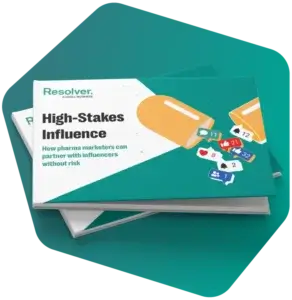In pharmaceutical marketing, one authentic story from a trusted patient advocate can be more powerful than a multimillion-dollar advertising campaign. This is the promise of influencer marketing: a direct, human connection to the communities you aim to serve.
However, for every story of success, there’s a cautionary tale of a partnership gone wrong — a compliance breach triggered by an off-script comment, or a brand reputation damaged by a partner’s controversial past. The difference between the two often comes down to one critical and frequently underestimated step: proactive due diligence.
Vetting influencers in a regulated industry like pharma isn’t just about checking their follower count or engagement rate. It’s a rigorous process of risk assessment. You are not just hiring a content creator. You are selecting a public face for your brand who will operate within a strict framework of legal and ethical guidelines.
Getting this choice right is the first and most important step in building a compliant, effective, and safe influencer marketing program. Failure to do so exposes your brand to significant regulatory penalties, reputational damage, and a loss of public trust.
Why vetting influencers is nonnegotiable in pharma
In consumer goods, a poorly chosen influencer might lead to an awkward PR moment. In pharma, the consequences are far more severe. The U.S. Food and Drug Administration (FDA) and Federal Trade Commission (FTC) do not distinguish between your corporate communications and the content produced by a paid partner. An influencer’s post is your post. Their unmonitored comments section is your responsibility. This shared ownership raises the stakes immensely.
Effective vetting serves three primary functions:
- Compliance assurance: It ensures your potential partner understands (or can be trained on) the principles of fair balance, risk disclosure, and transparency. You are looking for a partner who respects rules, not one who views them as creative constraints.
- Brand safety and alignment: An influencer’s personal brand, past content, and public statements become an extension of your own. A thorough background check prevents you from partnering with an individual whose personal views or past behavior could create a brand crisis.
- Audience authenticity: True influence comes from trust. Vetting helps you identify partners who have a genuine, credible connection to a specific patient or provider community. This ensures the partnership feels authentic, not transactional, which is key to building meaningful engagement.
Skipping this crucial step is like building a house without checking the foundation. It may look good for a while, but it’s only a matter of time before cracks begin to appear.
The vetting checklist: What to look for in an influencer
A robust vetting process goes far beyond surface-level metrics. It requires a deep dive into an influencer’s content, history, and audience. This process can be broken down into a clear, actionable checklist to ensure no stone is left unturned.
1. Content and communication style analysis
Before you even think about outreach, study the influencer’s work. Scrutinize their existing content library on all platforms.
|
Tone and professionalism: Is their tone aligned with your brand’s values? Do they communicate respectfully and responsibly, even on sensitive topics? Look for consistency in their messaging. |
|
|
Past healthcare content: Have they worked with other healthcare brands? If so, review that content carefully. Did they handle complex medical information responsibly? Were their disclosures clear and conspicuous? This is a strong indicator of their experience level. |
|
|
Engagement quality: Look beyond the number of comments and examine their substance. Is their audience engaged in supportive, constructive dialogue, or is the comments section a source of conflict and misinformation? |
2. Historical and background review
The internet never forgets. A thorough background check is essential to protect your brand from unforeseen reputational risks. One resurfaced comment or controversial association can derail an entire campaign.
|
Scan for controversial topics: Manually or with the help of a risk intelligence platform, search their past content and public statements for red flags. This includes discriminatory language, promotion of dangerous misinformation, or alignment with extremist views. |
|
|
Check for conflicts of interest: Are they currently working with a direct competitor? Have they previously made negative public statements about your company or products? |
|
|
Verify their story: If the influencer’s platform is built on a personal health journey, ensure their story is credible and consistent. While you must respect their privacy, look for major inconsistencies that could undermine their authenticity.
|
3. Audience and community health assessment
An influencer is only as valuable as the community they’ve built. You’re not just partnering with an individual; you’re engaging with their entire audience.
- Audience demographics: Does their audience align with your target patient or provider population? Most social platforms provide analytics that can help verify this.
- Audience sentiment: How does the community talk about the influencer? Are they seen as a trusted resource, or just an entertainer? Look for signs of a strong, positive relationship.
- Bots and engagement pods: High follower counts can be misleading. Use analytics tools to check for an unusually high percentage of bot followers or suspicious engagement patterns that suggest artificial inflation of their metrics.
|
Audience demographics: Does their audience align with your target patient or provider population? Most social platforms provide analytics that can help verify this. |
|
|
Audience sentiment: How does the community talk about the influencer? Are they seen as a trusted resource, or just an entertainer? Look for signs of a strong, positive relationship.
|
|
|
Bots and engagement pods: High follower counts can be misleading. Use analytics tools to check for an unusually high percentage of bot followers or suspicious engagement patterns that suggest artificial inflation of their metrics.
|
Balancing authenticity with compliance
One of the biggest challenges in pharma influencer marketing is striking the right balance. You want your partner to share their genuine story in their own voice, but you need them to do it within strict regulatory guardrails. This balance is achieved not by restricting creativity, but by providing clarity.
- Train, don’t script: The goal is to educate your influencer on the “why” behind the rules, not to hand them a rigid script. A mandatory training session on fair balance, adverse-event reporting, and FTC disclosures is essential. Translate complex legal requirements into simple “Do’s and Don’ts.” For example, instead of reciting FDA regulations, explain the importance of mentioning risks alongside benefits to keep their audience safe.
- Establish clear approval workflows: A multi-stage approval process ensures compliance without stifling authenticity. Review the initial concept, then the draft content, and provide clear, constructive feedback. This collaborative approach allows the influencer to retain their voice while ensuring the final post meets all legal and medical requirements.
- Empower them on disclosures: Be explicit about how and where to place disclosures like #ad or #BrandPartner. Explain that this transparency isn’t just a rule, but a critical part of building trust with their audience.
When an influencer understands the framework, they are free to be creative within it. This turns compliance from a barrier into a parameter for safe, authentic storytelling.
Your partner in confident influencer vetting
Choosing the right influencer is the foundation of a successful and compliant campaign. It requires a meticulous, multi-faceted approach that balances quantitative data with qualitative judgment.
By investing the time and resources into proper due diligence, you’re not just minimizing risk, you are laying the foundation for a powerful, authentic, and responsible partnership. You are choosing to build your brand on a foundation of trust.
This process is critical, but it doesn’t have to be overwhelming. Having the right framework and tools makes all the difference.
 |
The Influencer Guide Built for Pharma MarketersDownload our High-Stakes Influence e-book for actionable frameworks that help you partner without risk. |

